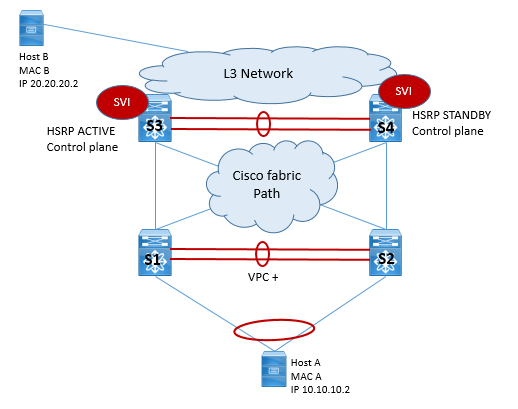EMAIL SUPPORT
dclessons@dclessons.comLOCATION
USHSRP Behaviour In FabricPath
As we know that in VPC+ HSRP acts as Active – Active while data forwarding and for control plane it acts as Active and Standby. For control plane population, Active will reply for ARP request. Once Active and Standby relation is completed, we can achieve Active- Active Forwarding.
Let’s learn how control plane is populated and how data plane work in HSRP when host in two different network wants to communicates with each other. Let’s see the below example to understand how it works.

In order to achieve HSRP Active and Standby, HSRP hello packets are sent on VPC+ peer core ports with Source MAC HSRP VMAC. These HSRP VMAC is also learned by fabricpath access switches against the VPC+ virtual switch ID. When a frame is sent to HSRP’s VMAC from the Fabric Path edge switch, the MAC address lookup table returns the vPC+ virtual switch-ID (SID) as the destination switch. When a frame is sent to HSRP VMAC from a host device connecting to a vPC+ port channel, the traffic can take any of the physical links in port channel and can arrive on either of the vPC+ peer switches.
- Now let’s suppose Switch S1 and Sw3 has announced its affinity to FTag 1 and likewise Switch Sw2 and Sw4 has announced its affinity to FTag 2.Now Host A with IP 10.10.10.2 wants to communicate with host B 20.20.20.2.
- Host A starts communication with Host B. As both are in different network Host A needs to send the frame to it’s the default gateway. Host A also don’t know the MAC address of the gateway, host A will send an ARP request with the broadcast destination MAC (ffff.ffff.fff) and source MAC (0000.0000.000A) of Host A.
- As ARP request is BUM traffic and suppose it reaches to Sw1 based on port-channel hash algo, it learns the MAC address of Host A and synchronizes it to Sw2 over CFSoE.
- Switch Sw1 has its affinity on FTag 1 forwards the broadcast ARP request over the multidestination tree with FTAG1.The source switch-ID used in the Fabric Path header is the virtual switch-ID 200 and both Switches Sw3 and Sw4 receive the ARP request frame. Switch Sw3 which is HSRP active has announced its affinity to FTAG1, will processes the ARP request and will sends an ARP response with the HSRP VMAC address with source switch-ID as virtual switch-ID of 100. Switch Sw4 drops the frame as it is received over the FTAG1, and Switch Sw4 has announced its affinity to FTAG2. Switches Sw3 and Sw4 will also learned the MAC address of Host A against the virtual switch-ID.
- The ARP reply from Switch Sw3 with source switch-ID of the virtual switch-ID 100 is sent back by Switch Sw3 with the destination switch-ID set to virtual switch-ID of 200 and now let’s assume that this packet arrives at Switch Sw2. The Switch Sw2 decapsulates the packet and it is aware of destination MAC of Host A (0000.0000.000A) Switch Sw2 learns the source MAC (HSRP VMAC) against the virtual switch-ID 100. Now frame is forwarded to Host A.
- Host A will now send a unicast frame to Host B with source MAC of Host A and destination MAC as HSRP VMAC. Based on the Port channel hash frame arrived at Switch Sw2. Sw2 encapsulates the packet with a destination switch-ID as the virtual switch- ID of 100 and forwards to fabric path domain. Now let’s say the frame arrived at Switch Sw4 after the ECMP computation in the Fabric Path network.
- As the HSRP data plane is active/active, Switch Sw4 decapsulates the packet, and after doing a Layer 3 routing lookup, the frame is forwarded over the Layer 3 network toward Host B.
- The frame reaches Host B. The reverse traffic from Host B to Host A will be forwarded through the FabricPath network in a similar manner.




LEAVE A COMMENT
Please login here to comment.